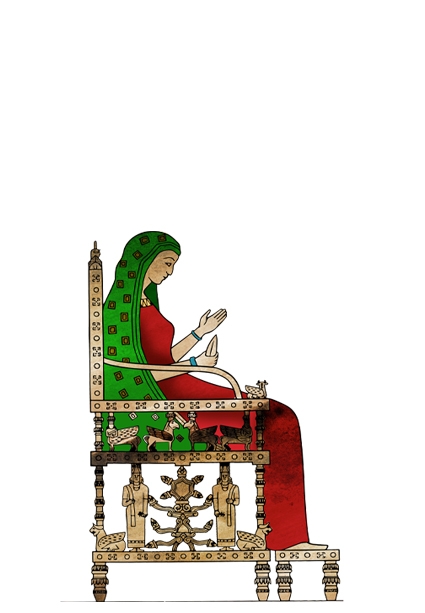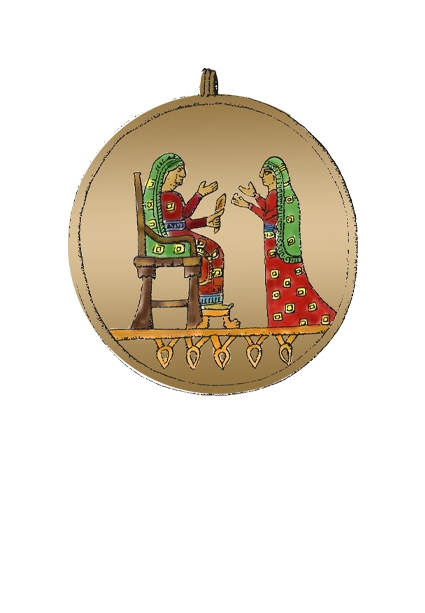Information on weaving in Urartu is obtained from a few archaeological findings from excavation centers such as Karmir-Blur, Patnos, Hasanlu, a number of written documents and interpretations of depictions on metal and stone.
In Urartu geography, livestock has always been the most important factor in life style and economic production. Especially wool obtained from small cattle is the primary raw material source of weaving. The herbal fibers and animal skin are also other important raw material sources for the same textile products.
Woolen fabric pieces with geometric motifs and attachments were detected in Karmir-Blur excavations. Textile samples were found in the warehouse building, possibly using to cover the mouths of the cubes in Ayanis, as for in Patnos, with burial gifts. The textile remains found in the Hasanlu IV layer associated with Urartu have been found to be made of wool, goat hair, vegetable and animal fibers. It has been suggested that textile can be used wall hanging and furniture covering for decorative purposes as well as garment production. In most of Urartu centers weaving weights and spindle whorls using in sliver were found in a large number. This shows that weaving is common in these settlements. The presence of the spindle whorls as a gift of the dead in some graves is also an important data for the importance of this effort in the social life.
If we look at the written documents about weaving, the most remarkable data comes from the cuneiform tablet found in Toprakkale. Here it is mentioned of 68 weaver women, who are probably the people in the service of the palace. An inscription found in Karmir-Blur mentions woolen fabrics, cattle, sheep and goat skins sent to another city. In another inscription belonging to the II. Sarduri period, there are 3,000 dresses among the spoils captured from the Qumaha king Kuştaşpili.
In the cuneiform anals in which II. Sargon tells about the looting of the Urartu devine city, Muşaşir, there are some information about Urartu textiles. The looted items include 130 brightly colored wool clothes, purple linen dresses, and wool for red clothings. Among the spoils captured from Haldi Temple, there are 9 clothes, -probably are used in rituals- decorated with gold badges and discs.
We can get some information about textiles and weavings on Urartian bronze works and some sculptures.
In the depictions of gods on the Anzaf Shield, the short skirt and the tunic on it is noticeable. The edges of the dress are tassels or embroidered. In addition, it is seen that the dress is made of a fabric with pattern of a round rosette and leaf extending in horizontal bows.
The Teisheba relief at Adilcevaz Kef Castle and the depictions on the embossed stone distinctions are remarkable. In the relief that the god Teisheba is depicted standing on the bull, the details of the clothes are seen. God wears a short skirt that extends to the kneecaps and a tunic that extends to the ankles. There are pattern of square, multi-arm star and eight-leaf rosette in the dress fabric. The dressing was terminated by thick strips with edges. The strips are in a different pattern, created with four-arm rosette.
A bronze figurine attributed to the goddess Arubani and reported to be in Van-Derebey gives information about women's clothing. Here a dress with a decoration extending to the ankles was worn. Square rosettes in the dress fabric are likely gold or silver inserts. The figure that was shown headscarfed, has three rows of beads on the neck and a bow on the waist. Again on a gold medallion in Van-Toprakkale, one sits on the throne, while the other standing on the opposite side, the two female figures were handled. They wore a dress that extended to the feet under a head scarf, which extended to the bottom of the waist. The edges of the headscarf are formed by a bow in a different pattern Again the pattern of the square rosette in the dress fabric is also observed here.
The depictions on the Urartian bows are another source of visual information. In one example, events that are likely to occur during a wedding ceremony are depicted. There is a narrative wording. On the weaving loom where two women are sitting, a patterned fabric is woven. Women are dressed in ankle-length dress. There are bows in the waist and some of them have headscarfs. It is understood that there are some patterns with horizontal and diagonal bows
Dokuma Örneği

Dokuma Örneği





